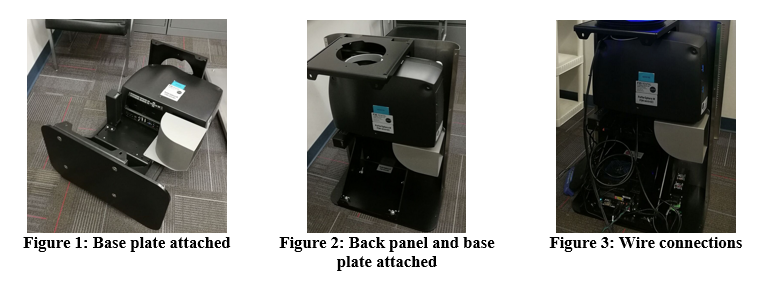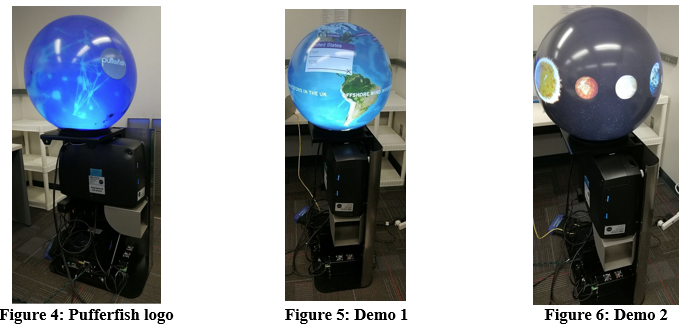In March, we received an interactive spherical display, the Puffersphere delivered from our partners, Pufferfish Ltd. The Puffersphere has a 360-degree viewing window with audio integration, and supports multi-touch interaction that allows the user to explore and manipulate content on the display. When the sphere arrived, our entire team was very excited to get started with the installation process. We had to both assemble the hardware and get the software up and running. For initial hardware and software set-up, we followed the installation manuals delivered with the system.
Setting up the hardware: Installation manuals provided necessary information for setting up the connections and organizing various system components. The system was delivered in four cases carrying the sphere, projector, enclosure panels (top, base plates, and the side panels), and the lens. The installation process began with securing the base plate to the projector frame (Figure 1). After attaching the base plate, we tightened the back enclosure panel using wingnuts and washers (Figure 2) and connected the projector to the router using an Ethernet cable. We also connected the projector to the App machine (computer) using the DVI cable. In addition to this, we connected the computer to a LED ring driver by USB, and further connected the LED cable and camera cable from the LED ring driver to the LED ring attached to the Sphere. After making all the connections (Figure 3), we attached the front panel and then attached the top plate to the frame. We were now ready to fit the lens to the projector. It was suggested in the installation manual to remove the top and the bottom cap of the lens to prevent any damage to the projector. To sharpen the focus of the projector, we projected the test pattern on a white sheet of paper (around 30 cm away from the lens) and adjusted the focus until the image was crisp. Ensuring that everything was in place, we joined the sphere to the top plate and attached the side panels.

Running demos on the sphere: After assembling the Puffersphere, we needed to calibrate it to balance the image correctly on the spherical screen. The instruction manual directed us to use the projector’s Lens Shift function – both horizontal and vertical for calibration on the Pufferfish test pattern. We tried using the Lens Shift control via the projector’s remote control but we were unsuccessful. We were unable to get the computer to use the projector as a monitor or the projector to recognize the computer as a source. We also found that when the router was plugged in, there were no lights turning on. After consulting with Pufferfish about these issues, the main problem seemed to be that the router was not working. In addition to this, there were some loose power cables. To help stabilize the cables, we decided to get a US power strip and use the default US power cables for better stability instead of using UK power strips.
To make our system work temporarily, we used another router of frequency 2.4 GHz (54 Mbps). After replacing the router, the computer began communicating with the projector, as we saw a blue sphere with the Pufferfish logo (Figure 4). However, we still faced issues accessing the controller application via the web browser (IP address: 192.168.1.40). To access the machine’s operating system, we connected through a VNC server and launched the Pufferfish External control app manually. But we were still not able to access the controller application. After some debugging, we noticed that the network was configured to public mode, and therefore the Windows firewall was blocking the connection. This might be because of using the new router with the system. After making the network private we could access the controller application and run the demos (Figure 5, 6). Now that the system was up and running, we were successfully able to calibrate the image on the sphere using the projector’s Lens Shift controls and the Pufferfish test patterns (with concentric circles).

I am a 1st year Ph.D. student in the Human Centered Computing Department at the University of Florida. It has been a thrilling experience to interact with the visually stimulating demos on the expertly designed 360-degree view window device. I am excited to start prototyping our first application on the Sphere.
by Nikita Soni
 0
0

Comments:
May 23, 2022
Hi Yilmazcan, I don't have that answer for you. I would suggest you reach out to the company, Pufferfish, Ltd., to get a more detailed answer and specifications. Apologies for the long delay on seeing your comment!
May 3, 2019
Great, thanks for reading and for sharing your experience! I think all manner of faculty research support is welcome and a great option.
May 2, 2019
Fundraising can be another option. I have a bachelor's in biology and master's in science communication, and I work with university faculty to identify and secure funding from companies and foundations.
August 17, 2018
So a followup on this - I have installed the extension in my browser, and when registering for a conference, it contextualizes the numbers for me. I haven't tried it on airfare or lodging though! friday and saturday Early rate: $300 [≈ cost of PS3 gaming system, 2011] Standard (9/8/18 on): $375 [≈ cost of a suit] friday only Early rate: $250 [≈ cost of PS3 gaming system, 2011] Standard (9/8/18 on): $325
February 23, 2018
Dear nikitasoni238 , Thank you for sharing your Interactive Global Screen experience. I am doing my research on this subject. I have had the chance to look into the product in detail as much as I can see in the photos. I know they use wide angles as lenses. Do you have any idea about how many mm? Best regards
March 23, 2016
Now I've found two more "D"'s added to STEM: STEM-D for design and disaster (as in education about natural disasters using STEM).
December 9, 2014
Update: this morning I picked up my latest issue of GSA Today, from the Geological Society of America. Their "Groundwork" commentary article describes a similar issue in fieldwork versus quantitative data, especially compounded by a bias in funding: http://www.geosociety.org/gsatoday/archive/24/12/article/i1052-5173-24-12-44.htm
Comments are closed.